Critical Decision Making in Healthcare
VerifiedAdded on 2020/05/16
|5
|1162
|25
AI Summary
This nursing assignment presents a case scenario where Mike, a lab technician, encounters a floor spill but is late for work due to prior warnings from his supervisor. He faces a dilemma: clean the spill potentially jeopardizing his job or proceed with clocking in, risking patient safety. The assignment analyzes the ethical and legal implications of Mike's decision, highlighting the potential for patient falls, litigation risks, and damage to hospital reputation. It concludes with a proposed disciplinary action against Mike and recommendations for improving floor cleaning procedures to prevent future incidents.
Contribute Materials
Your contribution can guide someone’s learning journey. Share your
documents today.
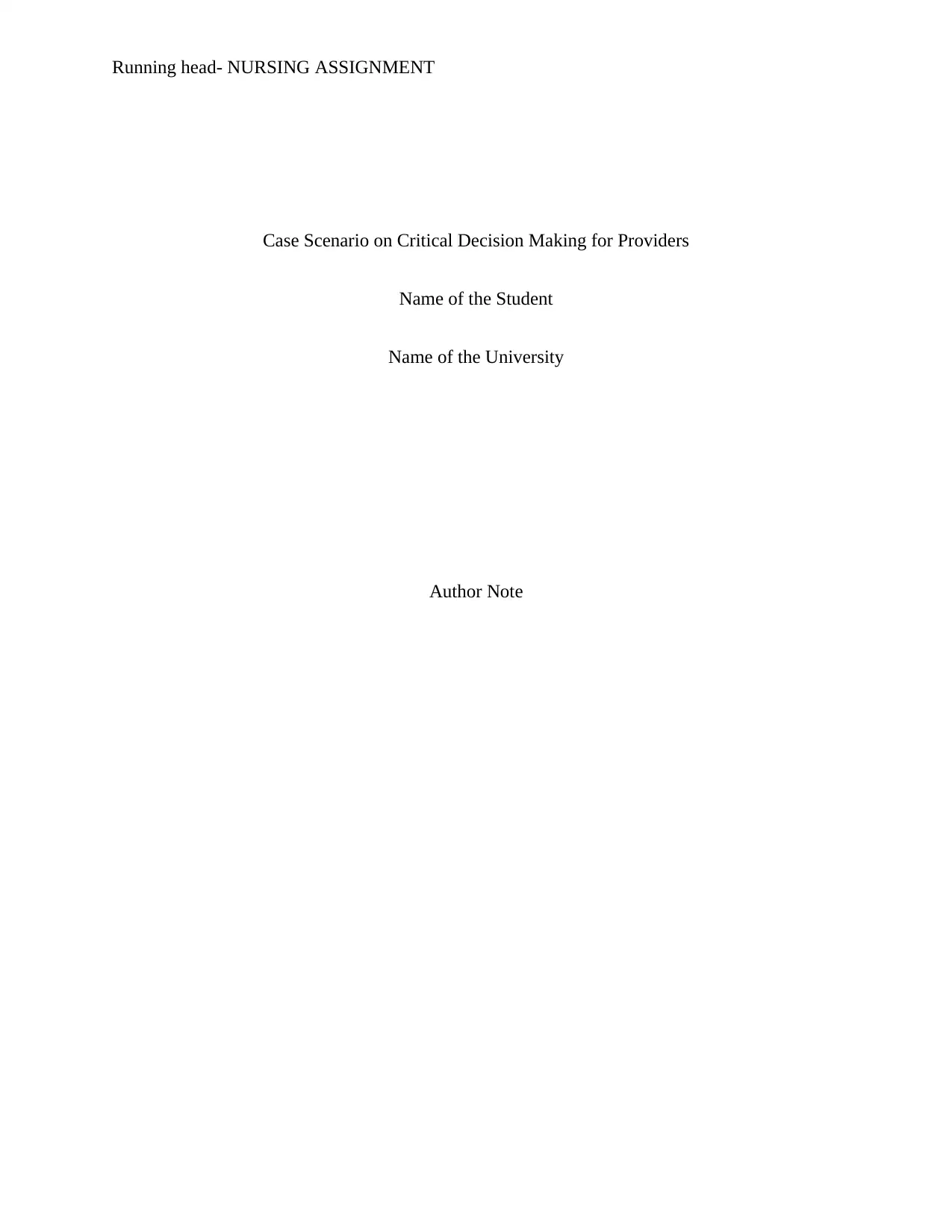
Running head- NURSING ASSIGNMENT
Case Scenario on Critical Decision Making for Providers
Name of the Student
Name of the University
Author Note
Case Scenario on Critical Decision Making for Providers
Name of the Student
Name of the University
Author Note
Secure Best Marks with AI Grader
Need help grading? Try our AI Grader for instant feedback on your assignments.
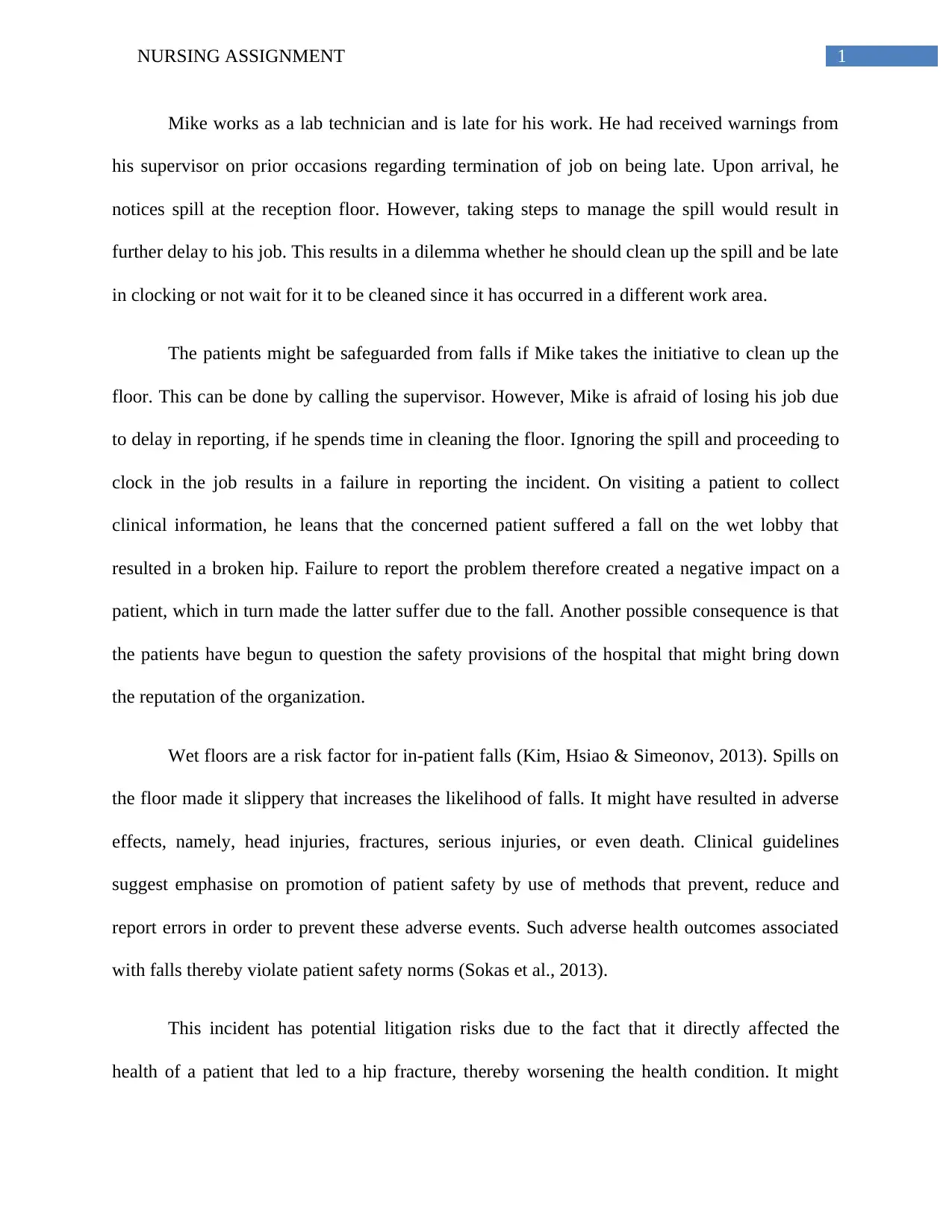
1NURSING ASSIGNMENT
Mike works as a lab technician and is late for his work. He had received warnings from
his supervisor on prior occasions regarding termination of job on being late. Upon arrival, he
notices spill at the reception floor. However, taking steps to manage the spill would result in
further delay to his job. This results in a dilemma whether he should clean up the spill and be late
in clocking or not wait for it to be cleaned since it has occurred in a different work area.
The patients might be safeguarded from falls if Mike takes the initiative to clean up the
floor. This can be done by calling the supervisor. However, Mike is afraid of losing his job due
to delay in reporting, if he spends time in cleaning the floor. Ignoring the spill and proceeding to
clock in the job results in a failure in reporting the incident. On visiting a patient to collect
clinical information, he leans that the concerned patient suffered a fall on the wet lobby that
resulted in a broken hip. Failure to report the problem therefore created a negative impact on a
patient, which in turn made the latter suffer due to the fall. Another possible consequence is that
the patients have begun to question the safety provisions of the hospital that might bring down
the reputation of the organization.
Wet floors are a risk factor for in-patient falls (Kim, Hsiao & Simeonov, 2013). Spills on
the floor made it slippery that increases the likelihood of falls. It might have resulted in adverse
effects, namely, head injuries, fractures, serious injuries, or even death. Clinical guidelines
suggest emphasise on promotion of patient safety by use of methods that prevent, reduce and
report errors in order to prevent these adverse events. Such adverse health outcomes associated
with falls thereby violate patient safety norms (Sokas et al., 2013).
This incident has potential litigation risks due to the fact that it directly affected the
health of a patient that led to a hip fracture, thereby worsening the health condition. It might
Mike works as a lab technician and is late for his work. He had received warnings from
his supervisor on prior occasions regarding termination of job on being late. Upon arrival, he
notices spill at the reception floor. However, taking steps to manage the spill would result in
further delay to his job. This results in a dilemma whether he should clean up the spill and be late
in clocking or not wait for it to be cleaned since it has occurred in a different work area.
The patients might be safeguarded from falls if Mike takes the initiative to clean up the
floor. This can be done by calling the supervisor. However, Mike is afraid of losing his job due
to delay in reporting, if he spends time in cleaning the floor. Ignoring the spill and proceeding to
clock in the job results in a failure in reporting the incident. On visiting a patient to collect
clinical information, he leans that the concerned patient suffered a fall on the wet lobby that
resulted in a broken hip. Failure to report the problem therefore created a negative impact on a
patient, which in turn made the latter suffer due to the fall. Another possible consequence is that
the patients have begun to question the safety provisions of the hospital that might bring down
the reputation of the organization.
Wet floors are a risk factor for in-patient falls (Kim, Hsiao & Simeonov, 2013). Spills on
the floor made it slippery that increases the likelihood of falls. It might have resulted in adverse
effects, namely, head injuries, fractures, serious injuries, or even death. Clinical guidelines
suggest emphasise on promotion of patient safety by use of methods that prevent, reduce and
report errors in order to prevent these adverse events. Such adverse health outcomes associated
with falls thereby violate patient safety norms (Sokas et al., 2013).
This incident has potential litigation risks due to the fact that it directly affected the
health of a patient that led to a hip fracture, thereby worsening the health condition. It might
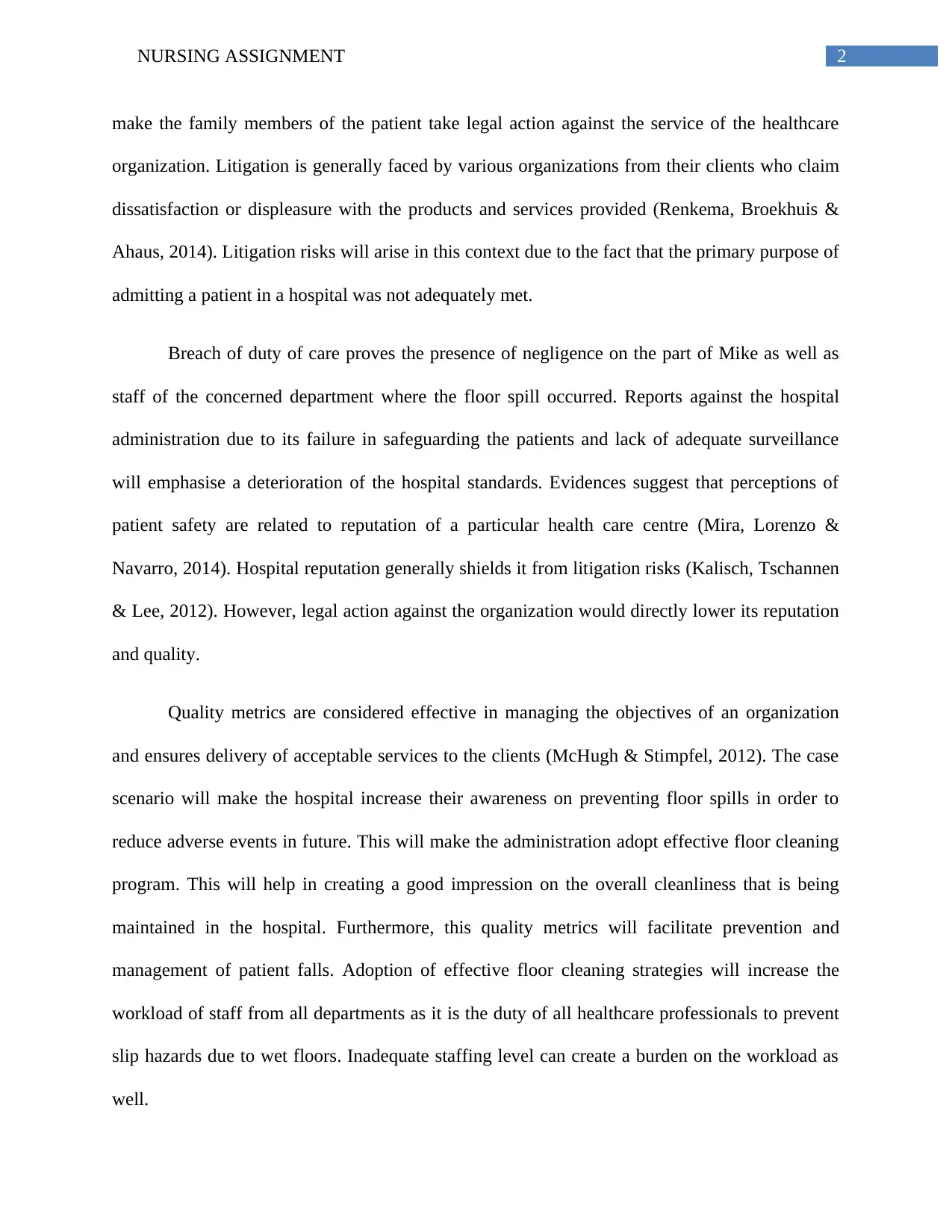
2NURSING ASSIGNMENT
make the family members of the patient take legal action against the service of the healthcare
organization. Litigation is generally faced by various organizations from their clients who claim
dissatisfaction or displeasure with the products and services provided (Renkema, Broekhuis &
Ahaus, 2014). Litigation risks will arise in this context due to the fact that the primary purpose of
admitting a patient in a hospital was not adequately met.
Breach of duty of care proves the presence of negligence on the part of Mike as well as
staff of the concerned department where the floor spill occurred. Reports against the hospital
administration due to its failure in safeguarding the patients and lack of adequate surveillance
will emphasise a deterioration of the hospital standards. Evidences suggest that perceptions of
patient safety are related to reputation of a particular health care centre (Mira, Lorenzo &
Navarro, 2014). Hospital reputation generally shields it from litigation risks (Kalisch, Tschannen
& Lee, 2012). However, legal action against the organization would directly lower its reputation
and quality.
Quality metrics are considered effective in managing the objectives of an organization
and ensures delivery of acceptable services to the clients (McHugh & Stimpfel, 2012). The case
scenario will make the hospital increase their awareness on preventing floor spills in order to
reduce adverse events in future. This will make the administration adopt effective floor cleaning
program. This will help in creating a good impression on the overall cleanliness that is being
maintained in the hospital. Furthermore, this quality metrics will facilitate prevention and
management of patient falls. Adoption of effective floor cleaning strategies will increase the
workload of staff from all departments as it is the duty of all healthcare professionals to prevent
slip hazards due to wet floors. Inadequate staffing level can create a burden on the workload as
well.
make the family members of the patient take legal action against the service of the healthcare
organization. Litigation is generally faced by various organizations from their clients who claim
dissatisfaction or displeasure with the products and services provided (Renkema, Broekhuis &
Ahaus, 2014). Litigation risks will arise in this context due to the fact that the primary purpose of
admitting a patient in a hospital was not adequately met.
Breach of duty of care proves the presence of negligence on the part of Mike as well as
staff of the concerned department where the floor spill occurred. Reports against the hospital
administration due to its failure in safeguarding the patients and lack of adequate surveillance
will emphasise a deterioration of the hospital standards. Evidences suggest that perceptions of
patient safety are related to reputation of a particular health care centre (Mira, Lorenzo &
Navarro, 2014). Hospital reputation generally shields it from litigation risks (Kalisch, Tschannen
& Lee, 2012). However, legal action against the organization would directly lower its reputation
and quality.
Quality metrics are considered effective in managing the objectives of an organization
and ensures delivery of acceptable services to the clients (McHugh & Stimpfel, 2012). The case
scenario will make the hospital increase their awareness on preventing floor spills in order to
reduce adverse events in future. This will make the administration adopt effective floor cleaning
program. This will help in creating a good impression on the overall cleanliness that is being
maintained in the hospital. Furthermore, this quality metrics will facilitate prevention and
management of patient falls. Adoption of effective floor cleaning strategies will increase the
workload of staff from all departments as it is the duty of all healthcare professionals to prevent
slip hazards due to wet floors. Inadequate staffing level can create a burden on the workload as
well.
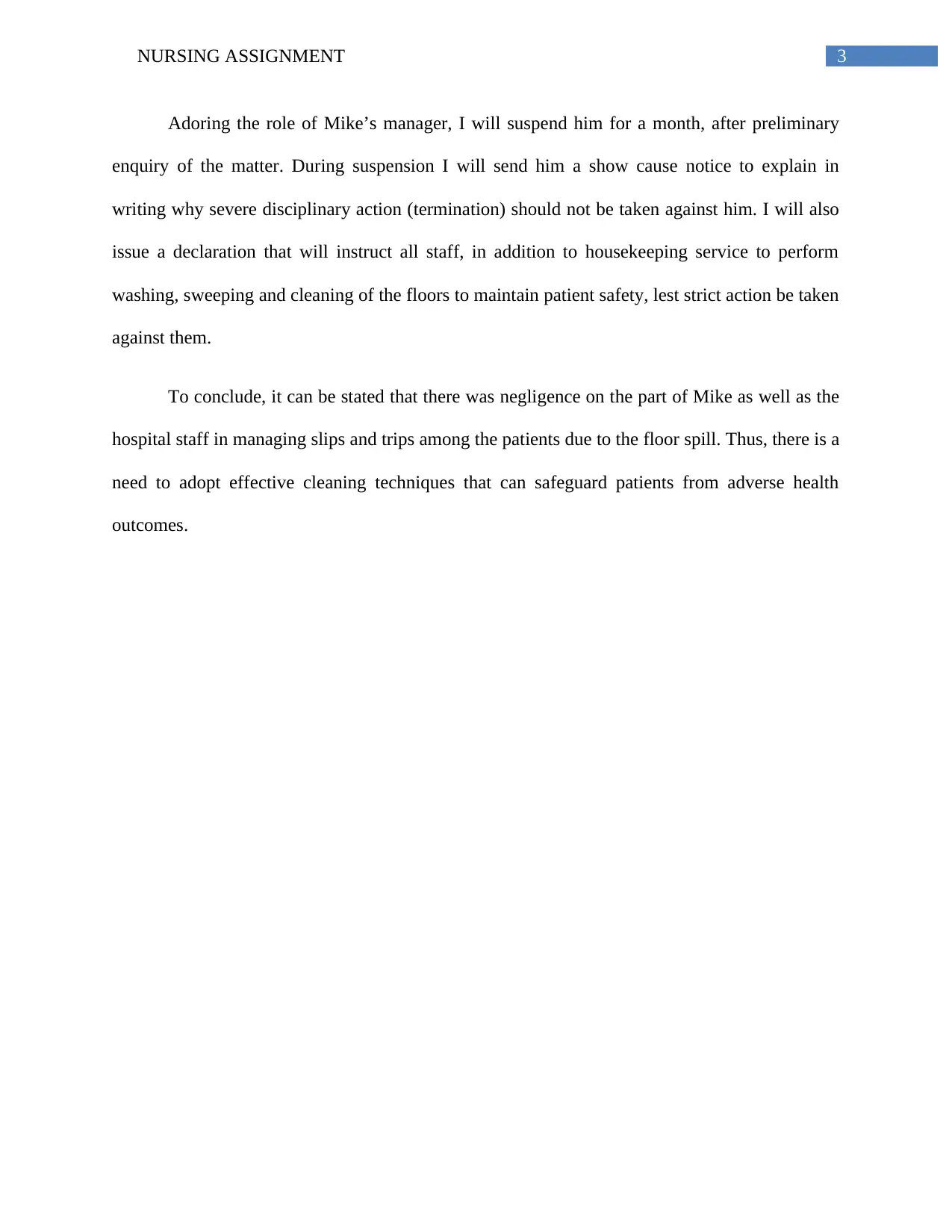
3NURSING ASSIGNMENT
Adoring the role of Mike’s manager, I will suspend him for a month, after preliminary
enquiry of the matter. During suspension I will send him a show cause notice to explain in
writing why severe disciplinary action (termination) should not be taken against him. I will also
issue a declaration that will instruct all staff, in addition to housekeeping service to perform
washing, sweeping and cleaning of the floors to maintain patient safety, lest strict action be taken
against them.
To conclude, it can be stated that there was negligence on the part of Mike as well as the
hospital staff in managing slips and trips among the patients due to the floor spill. Thus, there is a
need to adopt effective cleaning techniques that can safeguard patients from adverse health
outcomes.
Adoring the role of Mike’s manager, I will suspend him for a month, after preliminary
enquiry of the matter. During suspension I will send him a show cause notice to explain in
writing why severe disciplinary action (termination) should not be taken against him. I will also
issue a declaration that will instruct all staff, in addition to housekeeping service to perform
washing, sweeping and cleaning of the floors to maintain patient safety, lest strict action be taken
against them.
To conclude, it can be stated that there was negligence on the part of Mike as well as the
hospital staff in managing slips and trips among the patients due to the floor spill. Thus, there is a
need to adopt effective cleaning techniques that can safeguard patients from adverse health
outcomes.
Secure Best Marks with AI Grader
Need help grading? Try our AI Grader for instant feedback on your assignments.
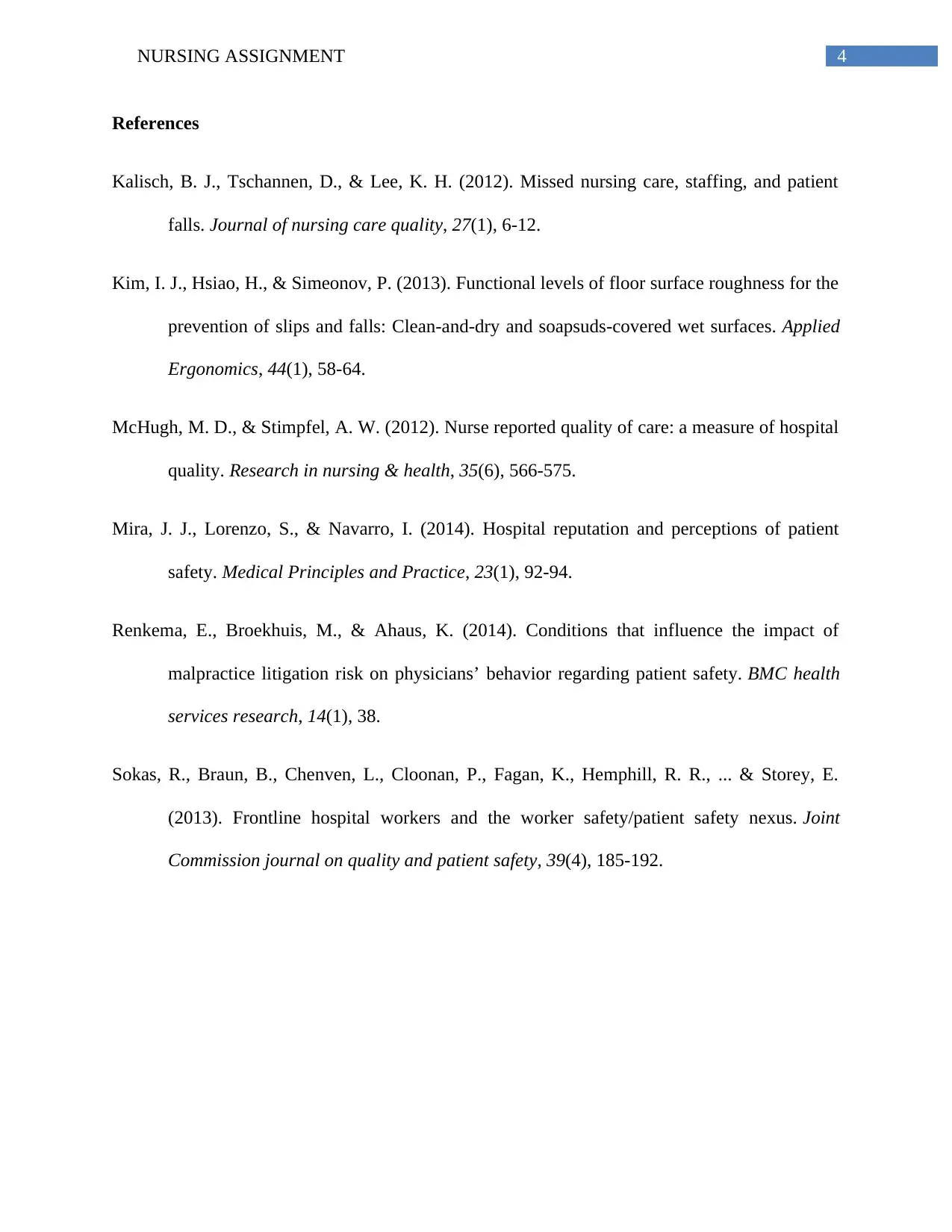
4NURSING ASSIGNMENT
References
Kalisch, B. J., Tschannen, D., & Lee, K. H. (2012). Missed nursing care, staffing, and patient
falls. Journal of nursing care quality, 27(1), 6-12.
Kim, I. J., Hsiao, H., & Simeonov, P. (2013). Functional levels of floor surface roughness for the
prevention of slips and falls: Clean-and-dry and soapsuds-covered wet surfaces. Applied
Ergonomics, 44(1), 58-64.
McHugh, M. D., & Stimpfel, A. W. (2012). Nurse reported quality of care: a measure of hospital
quality. Research in nursing & health, 35(6), 566-575.
Mira, J. J., Lorenzo, S., & Navarro, I. (2014). Hospital reputation and perceptions of patient
safety. Medical Principles and Practice, 23(1), 92-94.
Renkema, E., Broekhuis, M., & Ahaus, K. (2014). Conditions that influence the impact of
malpractice litigation risk on physicians’ behavior regarding patient safety. BMC health
services research, 14(1), 38.
Sokas, R., Braun, B., Chenven, L., Cloonan, P., Fagan, K., Hemphill, R. R., ... & Storey, E.
(2013). Frontline hospital workers and the worker safety/patient safety nexus. Joint
Commission journal on quality and patient safety, 39(4), 185-192.
References
Kalisch, B. J., Tschannen, D., & Lee, K. H. (2012). Missed nursing care, staffing, and patient
falls. Journal of nursing care quality, 27(1), 6-12.
Kim, I. J., Hsiao, H., & Simeonov, P. (2013). Functional levels of floor surface roughness for the
prevention of slips and falls: Clean-and-dry and soapsuds-covered wet surfaces. Applied
Ergonomics, 44(1), 58-64.
McHugh, M. D., & Stimpfel, A. W. (2012). Nurse reported quality of care: a measure of hospital
quality. Research in nursing & health, 35(6), 566-575.
Mira, J. J., Lorenzo, S., & Navarro, I. (2014). Hospital reputation and perceptions of patient
safety. Medical Principles and Practice, 23(1), 92-94.
Renkema, E., Broekhuis, M., & Ahaus, K. (2014). Conditions that influence the impact of
malpractice litigation risk on physicians’ behavior regarding patient safety. BMC health
services research, 14(1), 38.
Sokas, R., Braun, B., Chenven, L., Cloonan, P., Fagan, K., Hemphill, R. R., ... & Storey, E.
(2013). Frontline hospital workers and the worker safety/patient safety nexus. Joint
Commission journal on quality and patient safety, 39(4), 185-192.
1 out of 5
Your All-in-One AI-Powered Toolkit for Academic Success.
+13062052269
info@desklib.com
Available 24*7 on WhatsApp / Email
![[object Object]](/_next/static/media/star-bottom.7253800d.svg)
Unlock your academic potential
© 2024 | Zucol Services PVT LTD | All rights reserved.



